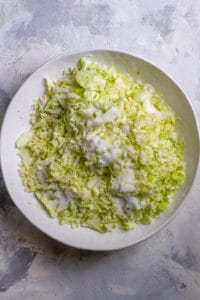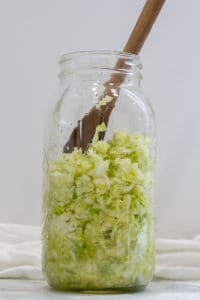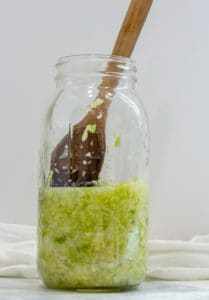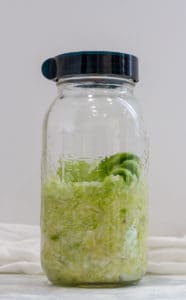Homemade Sauerkraut
Love sauerkraut? Try lacto-fermenting your own homemade sauerkraut! All you need is cabbage, salt, a glass jar, and a little time.
Servings: 16 people
Calories: 21kcal
Equipment
- Large Glass Jar (2 quarts minimum), or Multiple Smaller Jars
Ingredients
- 1 green cabbage (~3 lbs)
- 1 tablespoon sea salt
Instructions
Prepare the Cabbage:
- Remove the coarse outer leaves from the cabbage. Pick one or two unblemished leaves, rinse them off, and set them aside for later. Discard (or compost) the remaining outer leaves.
- Chop the cabbage into uniformly bite-sized pieces. Chop by hand or in a food processor. If using a food processor, take care not to pulverize the cabbage.Sizing Tip: You can use either large or very small pieces of cabbage. Large pieces will take longer to ferment, but very small pieces could become mushy more quickly. How large or small you chop your cabbage is up to you.
Massage the Cabbage:
- Add the cabbage to a large bowl. Add the salt.Use your hands to massage the salt into the cabbage. As you work, the cabbage will soften, turn a brighter green, and will begin to release liquid.

- Continue to massage the cabbage until water pools in the bowl. You should be able to lift a handful of cabbage, squeeze it, and see the liquid flowing freely back into the bowl.Tip: If the cabbage is not releasing liquid, cover the bowl, let it sit about 45 minutes to an hour, and try again.

Pack the Cabbage Into a Jar or Crock:
- Use your hands to transfer the cabbage into a clean glass jar or fermenting crock. Pour the liquid in the bowl on top of the cabbage.

- Use your fist, a tamper, or a large wooden spoon to press the cabbage down. The liquid should rise above the cabbage.Leave at least 4" of headspace between the cabbage and the top of the jar or crock.Tip: If you have a particularly dry head of cabbage, you can pour leftover brine from a previous batch of sauerkraut over the cabbage. Alternatively, mix up a batch of brine (ratio 1 gallon water to ½ cup salt), and add brine until the cabbage is submerged.

- Place one or two reserved cabbage leaves on top of the cabbage. Press down on the leaf to help keep the chopped cabbage submerged.

- If Using a Crock: Add the crock weights or a small plate, and place the lid on the crock.If Using a Jar: Jar Option 1: Weigh down the cabbage + Cover Jar with a Towel. Use a sealed glass jar filled with water (make sure it is small enough to be easily removed without breaking) or a sealed Ziplock bag filled with water to weigh down the cabbage. If you weigh down the cabbage, you can simply cover the jar with a tea towel instead of sealing the jar.Jar Option 2: Seal the Jar. Twist the lid onto the jar and seal it. You'll need to burp the jar daily to release the carbon dioxide gasses that build up in the jar. (You can use this option with or without a weight.)Jar Option 3: Use an Airlock Lid (My Preference). A third option is to use a fermenting airlock lid. These lids eliminate the need to burp the jar, and can be used with or without weighing down the cabbage.

Ferment the Cabbage:
- Set the jar somewhere you'll see easily each day, but out of direct sunlight. Depending on how much headspace you left (and if you're not using an airlock fermenting lid) you may want to place the jar on a rimmed baking sheet to catch any liquid that overflows.Check on the sauerkraut each day to make sure the cabbage is still submerged below liquid. If it's not, open the lid and push it down below the liquid.If you used a jar with a sealed (non-airlock) lid, burp the jar each day (for the first few days) to release the carbon dioxide gasses. These could build and cause the jar to break.
- Begin tasting the sauerkraut after about 4 days. Fermenting can take anywhere from 4 days to 3 months, depending on your preference and the temperature of the fermenting room.As the sauerkraut ferments, the flavor will mellow and become less acidic-tasting. The texture will soften. It's done fermenting when you like the flavor and texture.
- When you like the flavor and texture, transfer the sauerkraut into smaller jars. If using within a week, simply add the sauerkraut to smaller jars.If you're not using the sauerkraut immediately, press the sauerkraut down into the jars, and top with a small piece of wax paper. Pour brine on top of the paper.Store the sauerkraut in the fridge and use within a year.
Notes
Yields approx. 2 quarts of sauerkraut. Serving size estimated at ½ cup per person.
Troubleshooting
Most fermenting problems with sauerkraut come from trying to ferment in temperatures that are too warm for the fermentation process. Try to keep your jars in a room that's between 65 and 72 degrees Fahrenheit.
Surface growth: If you see anything "scummy" starting to grow on your sauerkraut while it's fermenting, scoop off the surface growth. Smell the cabbage. If it smells fine, it is fine. Keep the cabbage submerged into the liquid and continue fermenting.
Over-Fermenting: If your sauerkraut develops an awful smell (like rotting garbage), toss it out. If it smells a little funky (like sauerkraut), it's probably fine. If your cabbage has over-fermented, the smell will be terrible and you won't want to even try to taste it.
Nutrition
Calories: 21kcal | Carbohydrates: 5g | Protein: 1g | Fat: 1g | Saturated Fat: 1g | Polyunsaturated Fat: 1g | Monounsaturated Fat: 1g | Sodium: 451mg | Potassium: 145mg | Fiber: 2g | Sugar: 3g | Vitamin A: 83IU | Vitamin C: 31mg | Calcium: 34mg | Iron: 1mg
